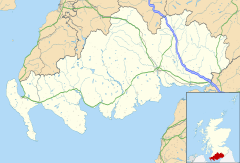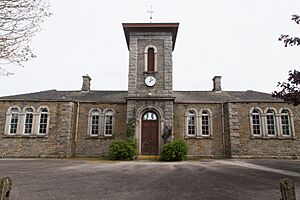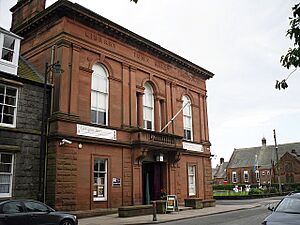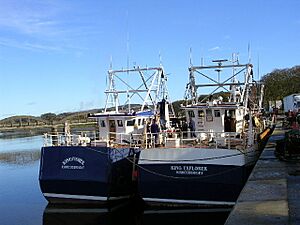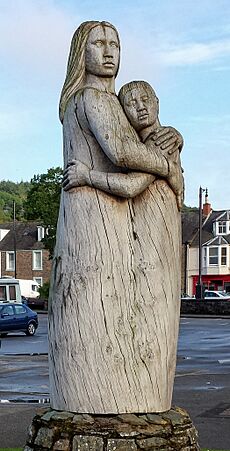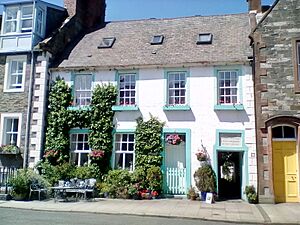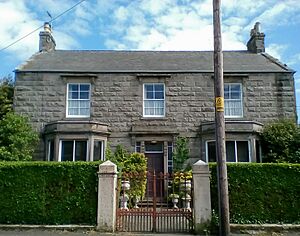Kirkcudbright facts for kids
Quick facts for kids Kirkcudbright
|
|
|---|---|
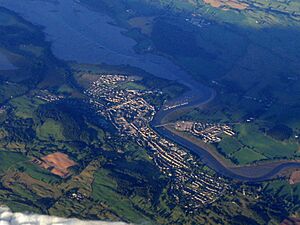 Aerial view of Kirkcudbright and the River Dee |
|
| Population | 3,350 (2020) |
| OS grid reference | NX685505 |
| • Edinburgh | 84 mi (135 km) |
| • London | 282 mi (454 km) |
| Council area | |
| Lieutenancy area | |
| Country | Scotland |
| Sovereign state | United Kingdom |
| Post town | KIRKCUDBRIGHT |
| Postcode district | DG6 |
| Dialling code | 01557 |
| Police | Dumfries and Galloway |
| Fire | Dumfries and Galloway |
| Ambulance | Scottish |
| EU Parliament | Scotland |
| UK Parliament |
|
| Scottish Parliament |
|
Kirkcudbright (ker kood brae) is a historic town in Dumfries and Galloway, Scotland. It's known as a "county town" because it was once the main town of Kirkcudbrightshire. It's also a "royal burgh," a special title given by the king or queen in 1455.
The town sits by the River Dee, about 4 miles (6.4 km) from the Irish Sea. It's southwest of Castle Douglas and Dalbeattie.
Contents
- History of Kirkcudbright
- What Does the Name Kirkcudbright Mean?
- Early Buildings and Important Visitors
- Becoming a Royal Burgh
- Battles and Sieges in Kirkcudbright
- The Historic Kirkcudbright Tolbooth
- The Johnston School's Legacy
- St Andrew's and St Cuthbert's Church
- Kirkcudbright's Railway History
- Kirkcudbright Town Hall Becomes a Gallery
- War Memorial
- Kirkcudbright Training Area
- Museums to Explore
- Kirkcudbright: The Artists' Town
- Famous People from Kirkcudbright
- Media in Kirkcudbright
- Sports in Kirkcudbright
- Images for kids
- See also
History of Kirkcudbright
Kirkcudbright has a long and interesting past, with its name and buildings telling stories of saints, kings, and famous people.
What Does the Name Kirkcudbright Mean?
The town's name comes from the old Scottish Gaelic words Cille Chuithbeirt. This means "chapel of Cuthbert". Saint Cuthbert was an important saint whose remains were kept here for a while. This happened before they were moved to Chester-le-Street.
Early Buildings and Important Visitors
In the 12th century, a group of monks called the Franciscans, or Grey Friars, settled in Kirkcudbright. They had a religious house here.
Later, in the late 1200s, John Balliol owned an old castle at Castledykes. It's said that Edward I of England stayed there in 1300 during his war against Scotland.
Becoming a Royal Burgh
In 1455, Kirkcudbright was given the special title of a royal burgh. This meant it had certain rights and privileges from the king.
Around 1570, Sir Thomas MacLellan of Bombie, a local leader, got permission from Queen Mary. He used parts of an old convent and nunnery to build a new parish church. He then took down the church to use its stones for his own grand home, MacLellan's Castle. This beautiful castle was built right on the old church site.
Battles and Sieges in Kirkcudbright
After losing a big battle called the Battle of Towton, Henry VI of England came to Kirkcudbright in 1461. He was trying to get support for Queen Margaret.
In 1547, the town faced a siege from the English army led by Sir Thomas Carleton. Kirkcudbright held out for some time. However, after the English took over the nearby countryside, the town had to surrender.
The Historic Kirkcudbright Tolbooth
The Kirkcudbright Tolbooth was built between 1625 and 1629. It was a very important building for the town. It served as the town's main office, a court, and a prison for both criminals and people who owed money.
One famous person held here was John Paul Jones. He was born nearby and later became known as the founder of the United States Navy. The Tolbooth was used until 1952 when the council moved to a new building.
The Johnston School's Legacy
The Johnston School was one of Kirkcudbright's primary schools. It was started thanks to money left by William Johnston, a merchant and shipowner. The school opened in 1847.
The original building was designed by James Newlands, who later created the world's first modern sewer system in Liverpool. The school building was rebuilt in 1933. Today, it's a community center.
St Andrew's and St Cuthbert's Church
This church was designed in 1886 in a Gothic style. It stands where a much older church once was. In 1971, the inside of the church was updated. It now features modern art, including a cross by Sean Rice and stained glass by Jerzy Faczynski.
Kirkcudbright's Railway History
The Kirkcudbright Railway opened in 1864. This brought trains to the town. However, the railway line and station closed in 1965.
Kirkcudbright Town Hall Becomes a Gallery
The Kirkcudbright Town Hall was finished in 1879. It's a listed building, meaning it's historically important. This building has now been turned into the Kirkcudbright Galleries. This new art space opened in 2018.
War Memorial
The town's war memorial was created in 1921 by sculptor George Henry Paulin. It remembers those who served.
Kirkcudbright Training Area
During the Second World War, a large area southeast of the town was taken over by the Army. This 4,700-acre (19 km²) area was used to train soldiers for the D-Day invasion. Today, it's still used for live-firing exercises. Part of it, the Dundrennan Range, tests weapons.
Museums to Explore
Kirkcudbright has several museums where you can learn more about its history and art.
Broughton House
Broughton House is an 18th-century house on the High Street. It was the home of famous Scottish artist Edward Atkinson Hornel from 1901 until he passed away in 1933. The National Trust for Scotland now looks after the house. It's a museum showing Hornel's life and work.
The Stewartry Museum
The Stewartry Museum started in 1879. It moved to its own special building because its collection grew so large. The museum tells the story of the local area, including its history and nature. It also holds Britain's oldest sports trophy, the Siller Gun.
The Tolbooth Arts Centre
The old Tolbooth building is now a lively arts centre.
Kirkcudbright: The Artists' Town
Kirkcudbright has been a popular place for artists for a long time. It's even known as "the Artists' Town." You'll see signs with this name as you enter.
Many artists live and work here. There's an artists' shop in the town center called The PA. Wasps (Workshop & Artists Studio Provision Scotland) has studios in two old townhouses. Many artists also open their studios to visitors during the Spring Fling Open Studios event.
The Kirkcudbright Arts & Crafts Trail happens every summer. This four-day event lets visitors see artists' studios and other special places.
Art Galleries in Kirkcudbright
You can visit several art galleries in Kirkcudbright. These include the Kirkcudbright Galleries, located in the old Town Hall, and the Harbour Cottage Gallery.
Kirkcudbright in Movies and Books
Kirkcudbright has inspired many stories and films.
Novels Set in Kirkcudbright
The 1907 novel Little Esson by S. R. Crockett is a mystery about the artists in Kirkcudbright.
The famous mystery novel Five Red Herrings by Dorothy L. Sayers also features the town's art community. In 1975, this book was made into a BBC TV show filmed right in Kirkcudbright.
Films and TV Shows
The town was also a filming location for the classic 1973 horror movie The Wicker Man.
In 1980, an adaptation of Ibsen's play An Enemy of the People was filmed in Kirkcudbright.
Music Inspired by Kirkcudbright
The Scottish songwriter Matt McGinn wrote a song called "The Wee Kirkcudbright Centipede." Other singers have also performed this song.
Famous People from Kirkcudbright
Kirkcudbright has been home to many notable people, including artists, sports figures, and other important individuals.
Artists Who Lived in Kirkcudbright
Kirkcudbright has a strong connection to the Glasgow art movement. Many artists, like the Glasgow Boys and Scottish Colourists such as Samuel Peploe and Francis Cadell, lived here between 1880 and 1910. They formed the Kirkcudbright Artists' Colony.
Other famous artists who moved here from Glasgow include Edward Atkinson Hornel, George Henry, and Jessie M. King. Later, artists like John Charles Lamont and Robert Sivell built studios across the river. Landscape painter Charles Oppenheimer moved to Kirkcudbright in 1908. He helped save the Harbour Cottage art gallery from being torn down.
Other artists from the area include:
- Joseph Simpson (1879–1939), a British painter.
- Phyllis Bone RSA (1894–1972), a Scottish sculptor.
- William Hanna Clarke (1882–1924), a painter whose works often showed the town.
Sportspeople from Kirkcudbright
- Bob McDougall (1894–1936), George Cloy, and David Mathieson (born 1978) were professional footballers who lived in the town.
- David MacMyn (1903–1978), a Scottish rugby international, was from Kirkcudbright.
Other Notable People
- Malcolm Caldwell (1931–1978), a British academic and writer.
- Cecil Coles (1888–1918), a composer born in Kirkcudbright who died in World War I.
- John Duncan (1805–1849), a Scottish explorer in Africa.
- Marriott Edgar (1880–1951), a lyricist and poet, known for "Albert and the Lion."
- John Erskine, 1st Baron Erskine of Rerrick (1893–1980), a banker and Governor of Northern Ireland.
- T. E. Lawrence (1888–1935), also known as Lawrence of Arabia, lived in Kirkcudbright as a baby.
- Gary Lewis (born 1957), an actor known for films like Billy Elliot, lives in Kirkcudbright.
- Sara Maitland (born 1950), a British writer of religious fantasy and short stories.
Media in Kirkcudbright
Local TV news for Kirkcudbright is provided by BBC Reporting Scotland on BBC One and ITV News Lookaround on ITV1. You can listen to BBC Radio Scotland on 93.1 FM and Greatest Hits Radio Dumfries & Galloway on 103.0 FM. The town also has local newspapers, the Dumfries & Galloway Standard and the Dumfries Courier.
Sports in Kirkcudbright
The town has a football team called St Cuthbert Wanderers FC. They play in the South of Scotland Football League. Some well-known former players include Bob McDougall, Billy Halliday, and David Mathieson.
Tour of Britain 2019
In 2019, Kirkcudbright was the finish line for the first stage of the 2019 Tour of Britain cycling race. The winner of that stage was Dylan Groenewegen from the Netherlands.
Images for kids
See also
 In Spanish: Kirkcudbright para niños
In Spanish: Kirkcudbright para niños


